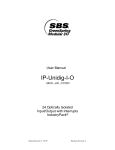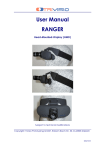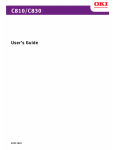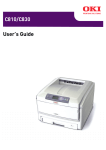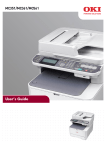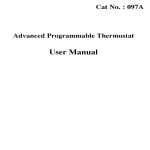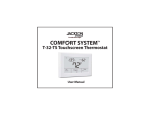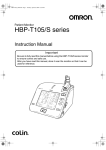Download T105 manual
Transcript
T105 Advanced Remote Control Programmable Thermostat User Manual TABLE OF CONTENT INTRODUCTION INSTALLATION OF RECEIVER SETTING OF CONTROL CENTER TESTING THE TRANSMISSION RANGE TEMPORARY OVERRIDE ANTI-FREEZING MODE BACK-LIGHT BATTERY REPLACEMENT POWER SWITCH LED INDICATOR SPECIFICATION 2 PAGE 1 8 13 20 20 21 22 22 23 23 24 INTRODUCTION This thermostat can replace most common residential thermostat and is designed to be used with electric, gas or oil heating control system or cooling system. Unlike those ordinary single unit design thermostat, T105 is a new type of thermostat separating the thermostat function into two units. The Receiver serves for wiring connections and heat/cool on/off control. The Control Center serves as user interface and temperature sensing / control. The two units are linked by RF. The advantage is that user can put the Control Center nearby and can read / control the temperature of really the living area. Outlook of Control Center: 3 LCD : Outlook of Receiver: Receiver and optional wall box 4 Receiver installed on wall box Power switch LED Indicators ON OFF Front View Front Cover Connect to Heating /Cooling Device Connect to Live Connect to Neutral 5 Features : Several useful function and operating modes have been incorporated to adapt a variety of customer needs besides all the features associated with the state of the art programmable thermostat. Control Center: - Can be placed at user living area to detect and control the temperature of the area where user really take activates. Not limited by power control wiring locations. - Link with the Receiver via RF. Control distance 100M open site - LCD shows the "need to know" information only, which is more easy to understand. - Real time clock with day of the week display - Room temperature display - Control profile display - Simplified temperature adjustment - Simplified programming procedure - 6 pre-defined control profiles, 3 user programmable control profile - A protection against freezing - Temporary override set-temperature - User selectable temperature span - User selectable heater/cooler operation mode 6 - Battery level detection 2 AA size alkaline batteries (not included) Slim housing design EL backlight Receiver: - Linked with Control Center via RF. Power control rating up to 230VAC 16A resistive. Powered by line voltage only. No battery required. Two LED indicators for power and output status. 7 INSTALLATION OF RECEIVER Caution : 1. The appliance can only be mounted on dry indoor places. 2. A suitable fuse with a rating not exceeding 20A, should be in the power line. 3. Observe the nation regulator for the wiring. 4. Qualified electrician is recommended for installation and servicing. This thermostat has been designed for simple and quick installation requiring only a few tools. Only the Power Control Unit need to be installed. Required Material Hammer Masking tape Screwdriver Drill and 3/16" drill bit (if not installed on a junction box) RF Address Code Setting If there is another user nearby, e.g. in the next house, 8 installs the same T105 unit, your receiver may be fault triggered by his/her transmitter. You may select a different RF address code to prevent this. Receiver can only response to RF coding with the same address code setting as its own address code. 1. To adjust address code of Receiver, simply push up one or more of the 5 dip switch levers . 2. To adjust address code of Control Center, open the housing of transmitter unit. See battery replacement section on how to open the housing. 3. Remove one or more of the jumper cap as shown in the diagram below. Caution : 1. Address code of Control Center must be the same as address code of Receiver. For any jumper cap removal of address code # in Control Center, same address code # of Receiver must be put to the UP position. 2. Disconnect AC power and remove batteries before adjusting address code. Remove one or more of the jumper cap to adjust RF address code. Address code # 1 - 5, from left to rigth 9 1 2 DIP 3 4 5 ON Push up one or more of the white levers to adjust Receiver address code. Address code # 1 - 5, from left to right. Removing your old thermostat CAUTION : to avoid electric shock, turn off the power of the heating/cooling system at the main power box in your home. Read the following instructions carefully before disconnecting the wires. 1. Turn off your old thermostat. 2. Remove the cover from the old thermostat. You may have to pull extra hard. 3. Unscrew the old thermostat from the wall plate. 4. Now find the screws attaching the wall plate to the wall, and remove them. You should now be able to pull the wall plate a small distance from the wall. Do not disconnect any wire yet, simply locate the wires. 10 WARNING: After removing the wall plate, if you find that it is mounted on a junction box (e.g. a box similar to one behind a light switch or electric outlet), high voltage circuit may be present and there is a danger of electric shock. Please consult a qualified electrician. Wire Labeling 1. Disconnect and identify each wire. 2. You may wish to tape the wires to the wall to keep them from slipping through the hole in the wall. If the hole in the wall is larger than necessary, fill it in order to prevent hot or cold air to penetrate the thermostat. In this manner, the thermostat will behave perfectly. Choosing a Location Note: for a new installation, choose a mounting location about five feet (1.5 meter) above the floor in an area with good air circulation and away from. 1. Drafts of dead air sports. 2. Air ducts. 3. Radiant heat from the sun or appliances. 4. Concealed pipes and chimneys. 11 Mounting the Receiver onto the wall/junction box: 1. Remove the front cover of the Receiver. (jump to step 4 if installed on a junction box) 2. Mark the holes position. 3. Drill two holes and insert the plastic anchors care fully into the holes until they are flush with the wall. 4. Connect the wires. 5. Push on the wires in the wall. 6. Fasten securely the Receiver to the wall with the two screws. 7. Cover up the unit with the front cover and installation is completed. Mounting the Receiver onto the optional wall box : 1. Remove the front cover of the Receiver. 2. Mark the holes position for the wall box. 3. Drill two holes and insert the plastic anchors care fully into the holes until they are flush with the wall. 4. Pull the wires into the wall box and fasten the wall box onto the wall. 5. Connect the wires. 6. Push on the wires in the wall box. 7. Fasten securely the Receiver to the wall box with the two screws. 8. Cover up the unit with the front cover and installation is completed. 12 Wiring Diagram The T105 thermostat can be used with any single stage heating or cooling system. Wire connection is as follows : Output Live Neutral SETTING OF CONTROL CENTER Heater/Cooler Selection Before making any selection in the control center, its back housing must be removed as follows : 13 Inside the Control Center after back housing is removed, you can find the DIP switch. These three switches are used to control the span and heat/cool system. Set the DIP switch (position 3) according to your selection of heater system or cooler system as the following diagram. Temperature Span Selection Span is the temperature difference between the turn on temperature and turn off temperature. For example, in heating system, if you set temperature to 20°C and span to 1°C, the heater will operate when the room temperature drops to 19.5°C and turns off when the temperature rises to 20.5°C. Set the DIP switch (position 1 & 2) according to your selection of temperature span as the following diagram. 14 Battery Installation Your thermostat is using two (2) "AA" size batteries to operate. To power-up the unit, insert two "AA" batteries into the battery compartment of the front housing. When power is applied for the first time, the display must show time and the day as well as the room temperature (for example 28.5°C). If the display is different, press the RESET button. Use a fine probe such as straightened paper clip to gently push the RESET button. After installation of the batteries, put back the back housing to the control center and then the stand. Before turning on the main switch of the system, press the reset button once .The thermostat is ready for use. 15 Setting Clock 1. Press the SET TIME button to clear all digits except the day indicator and the time display. The Day indicator is flashing. 2. While Day indicator is flashing, press UP or DOWN button to adjust. 3. Press the SET TIME button again, hour digits are flashing instead of day indicator. Press UP or DOWN button to adjust. Press and hold the UP or DOWN button will speed up the adjustment rate. 4. Press the SET TIME button again, minute digits are flashing instead of hour digit. Press UP or DOWN button to adjust. Press and hold the UP or DOWN button will speed up the adjustment rate. 5. Press the SET TIME button again to return to normal operation mode. 6. The unit will return to normal operation mode if no key is pressed for 10 seconds. Setting Control Temperature 1. Press the SET TEMPERATURE button to display the pre-defined set temperature. 2. Press the CONF/ECON button to toggle between the setting of economic mode and comfortable mode. 16 3. Press the UP or DOWN button to increase/decrease the set temperature by 0.5°C. 4. Press the SET TEMPERATURE button again to save the set temperature. 5. The unit will back to normal operation mode if no button is pressed for 10 seconds. 6. The default setting of comfortable mode is 21°C for heater mode and 23°C for cooler mode. And the economic mode is 18°C for heater mode and 26°C for cooler mode. Setting Program i) Select Week-Day 1. Press the SET PROGRAM button, the day indicator shows the program day and is flashing. Program number indicator shows the current program for the selected day. 2. Press the UP or DOWN button to select the day needed to program. You can select the whole week, working day, weekend,or individual day to program. 17 ii) Select Control Profile - Pre-defined 1. Press the SET PROGRAM button again, the day indicator stop flashing and the program number starts flash. 2. Press the UP or DOWN button to select the program profile. P1-P6 are predefined program, their profile are shown as follows. 18 3. If any of these programs is selected, press the SET PROGRAM button again to confirm this program for the specified day and back to normal operation mode. 4. Press the button will toggle the control temperature setting and advance the setting hour digit by one. Example: button is pressed. Hour Digit (Clock)is 2 and the 02 hour bar is flashing. icon is on and the operation mode for hour 01 is set to economic mode. 5. Press the button will terminate the setting procedure and back to normal operation mode. Example: button is pressed.Terminate the setting procedure and the new control profile is : 6. The setting procedure will terminate automatically when no button is pressed for 10 seconds. 19 TESTING THE RF TRANSMISSION RANGE 1. Press UP button until the setpoint temperature is higher than room temperature by a few degree. 2. Wait for a few seconds. 3. Check the green LED. It should be On. 4. If the LED is not On, try to locate the Control Center closer to the Receiver. Press Down button to adjust the setpoint temperature to be lower than room temperature to "turn of" the receiver. 5. Repeat steps 1 to 3. 6. The receiving range between Control Center and Receiver is 100M in open area. When placed indoor, this distance may be shorter because of blocking by concrete wall etc, but is enough for most household application. 7. Press RESET button after receiving range testing. TEMPORARY OVERRIDE Override the Operation Mode At the normal operation mode, press the CONF/ECON button will toggle the current set temperature to comfortable mode or economic mode. If the operation mode is being override, the HAND icon 20 will be turned on with the current operation mode icon. Override the Setting Temperature 1. At the normal operation mode, the current set temperature can be override by pressing the UP or DOWN button. When override, the new set temperature will be displayed with turning on the HAND icon and off both the CONF and ECON icon. 2. Press other button (except the UP or DOWN button) will terminate the setting procedure and back to normal mode with the new setting. 3. The unit will back to normal operation mode automatically when no button is pressed for 10 seconds. ANIT-FREEZING MODE 1. Pressing the UP and DOWN buttons simultaneously will activate the anti-freezing mode (for heater mode only). The ANTI-FREEZING icon and the HAND icon will be turned on while both the COMF and ECON icon will be turned off. 2. Pressing any button will terminate the anti-freezing mode and back to normal operation mode. 21 3. The default set temperature for the anti-freezing mode is 7°C BACK- LIGHT Press the BACK-LIGHT button will turn on the backlight. The back-light will be off when no button is pressed for 10 seconds. BATTERY REPLACEMENT It is recommended to replace the batteries when the display is showing the battery-low icon. To replace the battery, 1. Turn off the power of the Receiver first. 2. Remove the back housing and stand of the Desktop Unit. 3. Replace the old batteries with 2 new AA alkaline batteries. 4. Replace the back housing and stand. 5. Press the reset button once and then turn on the power switch of the Receiver. 22 POWER SWITCH There is a power switch on the Receiver. When there is no demand to turn on the heating / cooling device, e.g. when you go out for long vacation, it is recommended to turn the power switch at Off position. LED INDICATOR There are Two LED on Power Control Unit as status indicator : 1. Red LED turns on as long as 230VAC power is turned on. When there is no power to the unit or when power switch underneath the front cover is put at Off position, the red LED is Off. 2. Green LED turns on as long as the heating / cooling device is energized. 23 SPECIFICATION Physical Characteristic Size Weight : Control Center 116 x 100 x 23.5 mm Receiver 91.5 x 91.5 x 42 mm : Control Center 126g Receiver 176g Electrical Characteristic Power Source : Control Center 2 AA (LR6) batteries Receiver 230VAC 50Hz Switching cap : 16A for resistive load 8A for inductive load Clock accuracy : +/- 60 seconds/month Temp. measurement : 0°C to 40°C in 0.5°C resolution Temp. accuracy : +/- 1°C at 20°C Temperature Control : 7°C to 30°C in step of 0.5°C Span : 1,2,3 or 4°C Air conditioner cycle time : 3 minutes Operation temperature : 0°C to 40°C Storage temperature : -10°C to 60°C 24
























